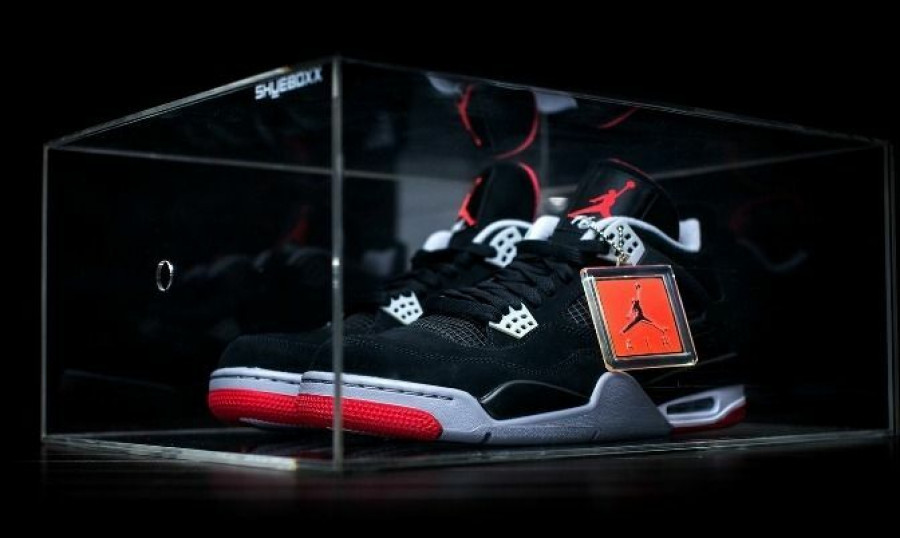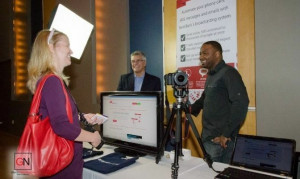Now as adults with discretionary income – Roach a graphic designer and Gentles a product marketing specialist – they can buy the pricey re-releases of their old coveted shoes. But what to do with them?
“We thought it’d be pretty cool if we had something to actually display and store them in because they just come in a plain cardboard box.” Roach transitions seamlessly from that passing thought to: “We ended up sourcing a manufacturer.”
Shueboxx is a simple concept. But look for something similar, and you’ll see it’s still a novelty. A retractable drawer made of transparent Acrylic, Shueboxx’s owners also wanted to ensure customers could personalize their product with laser etchings or decals. Customized orders account for about 75 percent of the business.
Roach educates me on “the sneaker world,” explaining that there’s a culture of enthusiasts that collect shoes the way sports fans once did baseball cards – often not wearing them but saving them as investments or proud displays. He tells me that some limited-edition pairs can be worth upwards of $3,000 to $4,000 due to limited supply, great interest and pitch-perfect marketing.
“They’re almost like pieces of artwork,” says Roach. “It’s the equivalent of wearing a Chanel bag for women.”
Roach estimates his own collection includes “only” 20 to 30 sneakers, including a vintage pair of Air Jordan 3s and a limited edition Transformers pair. He says Gentles is the greater enthusiast, with a large collection of valuable vintage shoes.
While Shueboxxes are mostly used for sneakers, Roach says he’s seen them used for wedding gifts, purses and jerseys and will soon be sold for jewelry, watches and ties as well. Perhaps the sweetest function he describes is the box in one customer’s office that displays his newborn’s shoes in a Shueboxx mini.
They track stories of their boxes with their Instagram account – “which has been an incredible tool” – using the hashtag #whatsinyourshueboxx.
Gentles and Roach have been friends since junior high where they were both serious basketball players and “big shoe nuts." They stayed in touch intermittently over the years and bonded after having two sons each.
“We talked about doing something together and ended up reverting back to what we love.”
And business moved quickly. They began planning in August last year working 15-hour days. They registered their business in October and sold out their limited stock at the Sole Exchange convention in Oshawa last November.
“That demand right away was incredible, we’ve been very fortunate. That boom in the beginning really helps... It’s a good motivator.”
“We were happy to sell one to somebody,” says Roach, laughing. So he beams when he tells me that in March, they sold out again at Mississauga’s Sole Exchange show and have filled orders from Alaska to L.A. to Texas and Minnesota (they’ve received requests from as far away as The Philippines but aren’t currently shipping abroad).
The two had much of the knowledge needed for the business but Roach emphasizes the importance of drafting a business plan first. “It’s rare you have the time to go back and do it.”
What they didn’t have was knowledge of the complicated world of importing.
Roach says they found support at Enterprise Toronto, where a small business consultant helped them tremendously by guiding them through set-up and the process involved in importing the boxes. “That pamphlet pretty much had all the steps laid out there for us.”
The business partners consult Enterprise Toronto’s YouTube channel and online workshops for guidance as well.
While they are currently operating at full-speed, part-time, Roach says the dream would be to turn this “hobby” into a full-time expansive business.
And to pass the business onto their children – ranging from three to 13 years old – would be something too. “In the back of your mind, you hope to leave them with something.”
“And they’re already into shoes. The genes are probably somewhere in them.”
This story originally appeared in Enterprise Toronto, by Deena Douara.

 By
By 





